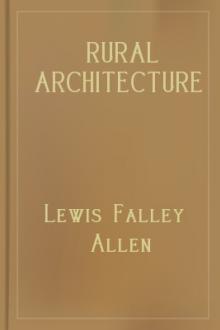Rural Architecture by Lewis Falley Allen (accelerated reader books .txt) 📖

- Author: Lewis Falley Allen
- Performer: -
Book online «Rural Architecture by Lewis Falley Allen (accelerated reader books .txt) 📖». Author Lewis Falley Allen
A main floor, A, 12 feet wide, runs the whole length through the center of the barn. S, S, are the large doors. H, H, are trap doors, to let hay or straw down to the alleys of the stables beneath. B, is the principal bay for hay storage, 16 feet wide, and runs up to the roof. C, is the bay, 26×16 feet, for the grain mow, if required for that purpose. D, is a granary, 13×16 feet, and 8 feet high. E, a storage room for fanning mill, cutting-box, or other machinery, or implements, of same size and height as the granary. F, is a passage, 8 feet wide, leading from the main floor to the yard door, through which to throw out litter. Over this passage, and the granary, and store-room, may be stored grain in the sheaf, or hay. The main floor will accommodate the thrashing-machine, horse-power, cutting box, &c., &c., when at work. A line of movable sleepers, or poles, may be laid across the floor, 10 feet above it, on a line of girts framed into the main posts, for that purpose, over which, when the sides of the barn are full, either hay or grain may be deposited, up to the ridge of the roof, and thus afford large storage. And if the demands of the crops require it, after the sides and over the floor is thus filled, the floor itself may, a part of it, be used for packing away either hay or grain, by taking off the team after the load is in, and passing them out by a retreating process, on the side of the cart or wagon; and the vehicle, when unloaded, backed out by hand. We have occasionally adopted this method, when crowded for room for increased crops, to great advantage. It requires somewhat more labor, to be sure, but it is much better than stacking out; and a well-filled barn is a good sight to look upon.

MAIN FLOOR PLAN.
Underneath the body of the barn are the stables, root cellar, calf houses, or any other accommodation which the farm stock may require; but, for the most economical objects, is here cut up into stables. At the ends, l, l, are passages for the stock to go into their stalls; and also, on the sides, for the men who attend to them. The main passage through the center double line of stalls is 8 feet wide; and on each side are double stalls, 6½ feet wide. From the two end walls, the cattle passages are 5 feet wide, the partition between the stalls running back in a slant, from 5 feet high at the mangers to the floor, at that distance from the walls. The mangers, j, j, are 2 feet wide, or may be 2½ feet, by taking an additional six inches out of the rear passage. The passage is, between the mangers, 3 feet wide, to receive the hay from the trap doors in the floor above.

UNDER-GROUND PLAN AND YARD.
The most economical plan, for room in tying cattle in their stalls, is to fasten the rope, or chain, whichever is used, (the wooden stanchion, or stanchel, as it is called, to open and shut, enclosing the animal by the neck, we do not like,) into a ring, which is secured by a strong staple into the post which sustains the partition, just at the top of the manger, on each side of the stall. This prevents the cattle in the same stall from interfering with each other, while the partition effectually prevents any contact from the animals on each side of it, in the separate stalls. The bottom of the mangers, for grown cattle, should be a foot above the floor, and the top two and a half feet, which makes it deep enough to hold their food; and the whole, both sides and bottom, should be made of two-inch, sound, strong plank, that they may not be broken down. The back sides of the stalls, next the feeding alleys, should be full 3½ feet high; and if the cattle are large, and disposed to climb into their mangers with their fore-feet, as they sometimes do, a pole, of 2½ or 3 inches in diameter, should be secured across the front of the stall, next the cattle, and over the mangers—say 4½ feet above the floor, to keep them out of the manger, and still give them sufficient room for putting their heads between that and the top of the manger, to get their food. Cattle thus secured in double stalls, take up less room, and lie much warmer, than when in single stalls; besides, the expense of fitting them up being much less—an experience of many years has convinced us on this point. The doors for the passage of the cattle in and out of the stables, should be five feet wide, that they may have plenty of room.
In front of these stables, on the outside, is a line of posts, the feet of which rest on large flat stones, and support the outer sill of the barn, and form a recess, before named, of 12 feet in width, under which may be placed a line of racks, or mangers for outside cattle, to consume the orts, or leavings of hay rejected by the in-door stock; or, the manure may be housed under it, which is removed from the stables by wheel-barrows. The low line of sheds which extend from the barn on each side of the yard, may be used for the carts, and wagons of the place; or, racks and mangers may be fitted up in them, for outside cattle to consume the straw and coarse forage; or, they may be carried higher than in our plan, and floored overhead, and hay, or other food stored in them for the stock. They are so placed merely to give the idea.
There may be no more fitting occasion than this, perhaps, to make a remark or two on the subject of managing stock in stables of any kind, when kept in any considerable numbers; and a word may not be impertinent to the subject in hand, as connected with the construction of stables.
There is no greater benefit to cattle, after coming into winter quarters, than a straight-forward regularity in everything appertaining to them. Every animal should have its own particular stall in the stable, where it should always be kept, and in no other. The cattle should be fed and watered at certain hours of the day, as near as may be. When let out of the stables for water, unless the weather is very pleasant, when they may be permitted to lie out an hour or two, they should be immediately put back, and not allowed to range about with the outside cattle. They are more quiet and contented in their stables than elsewhere, and eat less food, than if permitted to run out; and are every way more comfortable, if properly bedded and attended to, as every one will find, on trying it. The habit of many people, in turning their cattle out of the stables in the morning, in all weathers—letting them range about in a cold yard, hooking and thorning each other—is of no possible benefit, unless to rid themselves of the trouble of cleaning the stables, which pays twice its cost in the saving of manure. The outside cattle, which occupy the yard, are all the better, that the stabled ones do not interfere with them. They become habituated to their own quarters, as the others do to their's, and all are better for being each in their own proper place. It may appear a small matter to notice this; but it is a subject of importance, which every one may know who tries it.
It will be seen that a driving way is built up to the barn doors at the ends; this need not be expensive, and will add greatly to the ease and convenience of its approach. It is needless to remark, that this barn is designed to stand on a shelving piece of ground, or on a slope, which will admit of its cellar stables without much excavation of the earth; and in such a position it may be economically built. No estimate is given of its cost, which must depend upon the price of materials, and the convenience of stone on the farm. The size is not arbitrary, but may be either contracted or extended, according to the requirements of the builder.
(299)
(300) 
Here is presented the design of a barn built by ourself, about sixteen years since, and standing on the farm we own and occupy; and which has proved so satisfactory in its use, that, save in one or two small particulars, which are here amended, we would not, for a stock barn, alter it in any degree, nor exchange it for one of any description whatever.
For the farmer who needs one of but half the size, or greater, or less, it may be remarked that the extent of this need be no hindrance to the building of one of any size—as the general design may be adopted, and carried out, either in whole or in part, according to his wants, and the economy of its accommodation preserved throughout. The principle of the structure is what is intended to be shown.
The main body of this barn stands on the ground, 100×50 feet, with eighteen-feet posts, and a broad, sheltering roof, of 40° pitch from a horizontal line, and truncated at the gables to the width of the main doors below. The sills stand 4 feet above the ground, and a raised driving way to the doors admits the loads of grain and forage into it. The manner of building the whole structure would be, to frame and put up the main building as if it was to have no attachment whatever, and put on the roof, and board up the gable ends. Then frame, and raise adjoining it, on the long sides, and on the rear end—for the opposite gable end to that, is the entrance front to the barn—a continuous lean-to, 16 feet wide, attaching it to the posts of the barn, strongly, by girts. These ranges of lean-to stand on the ground level, nearly—high enough, however, to let a terrier dog under the floors, to keep out the rats—but quite 3 feet below the sills of the barn. The outer posts of the lean-to's should be 12 feet high, and 12½ feet apart, from center to center, except at the extreme corners, which would be 16 feet. One foot below the roof-plates of the main building, and across the





Comments (0)